My backpack
You don't have anything in your backpack at the moment.
Add destinations, sights and events by clicking this icon on individual pages:
![]()
Packed everything? Then send the backpack to yourself or your companion and set off.
The extracurricular place of learning Naturparkhouse Tiergarten Schloss Raesfeld offers events in nature on the habitats of forest, meadow, water and soil. Among other things, the pupils are invited to get to know the forest in spring and autumn. Phenomena corresponding to the seasons, such as the early bloomers in spring, the variety of forest fruits in autumn and the feeding marks on spruce cones in winter, are addressed. All offers of the extracurricular learning location enable the pupils to experience nature with all their senses.
The learning workshop Naturparkhouse Tiergarten Schloss Raesfeld will, as well as the learning workshop Biotopwildpark Anholter Schweiz, in the design and implementation of their educational programs for school classes intensively from ESD regional center “Foundation for Nature and Landscape Westmünsterland' in Zwillbrock supports. The schools in the district Borken As a result, a comprehensive range of ESD training programs on different topics is available at three locations. Education for Sustainable Development (ESD) enables everyone to understand the impact of their own actions on the world and to make responsible decisions.
Experience nature with all your senses
Duration: 2,5 - 3,5 hours
There is a lot to explore in nature! Bright colors, a wide variety of materials and a variety of smells sharpen the senses, stimulate the imagination and awaken the spirit of discovery! In this excursion the students are given a lot of space and time to perceive nature with all their senses. Nature experience games help to draw attention to nature. The pupils listen to the sounds of the forest, smell the countless aromas and feel trees, plants and other natural objects with their hands. You feel the forest floor under your feet and focus your gaze on very special natural treasures. Playful activities in the forest and the use of forest materials enable the pupils to develop a personal approach to nature and to experience themselves as part of nature. This creates an emotional basis for the careful handling of the living environment. The pupils discover the biological diversity of their environment in a special way and receive knowledge of its importance and protection. They train their sensory perception, their ability to concentrate and their motor skills. Direct experiences of nature also strengthen self-confidence and well-being and promote the relationship between people and nature. The influence of people on nature is recognized. This topic can be chosen as a separate topic or combined with other topics.

ground
Duration: 2,5 - 3,5 hours
Soil is more than just "dirt" - it is the basis of life for people, animals and plants! Soil serves as a building material and supplier of raw materials, as a water storage and filter, as a storage location for fossil fuels and much more. Depending on the type of soil, there are not only different possible uses, but conclusions can also be drawn about the potential natural communities of plants and animals. There can be more living things in a handful of soil than there are humans on earth! In this excursion, the pupils get to know the diversity of the topic of soil. They research the properties of different soil types and reflect on soil use, soil threats and soil protection. The pupils deal with the decomposition of leaves and humus formation, go in search of soil animals and recognize the special adaptations of living beings to their habitat. Different nature adventure games allow an informal approach to the topic.
Forest
Im Tiergarten Schloss Raesfeld you can find different types of forest in a relatively small area. In addition to mixed deciduous forests (oak, beech), there are also coniferous stands (spruce, pine, larch) and alder quarries. A large number of other deciduous and coniferous tree species can also be found along the paths.
Depending on the season, there are different focal points for an excursion, for example:
The forest in spring
Duration: 2,5 - 3,5 hours
In spring nature awakens to new life! Countless birds are chirping and soon you can see many animals in their efforts to find a mate. On the way in the forest, the pupils can hear the drumming of the great spotted woodpecker and discover the traces he leaves on many trees. Frogs and toads also become active again in spring and move to their spawning grounds. The pupils explore the life cycle of the amphibians and get to know the concept of metamorphosis. But things are not only happening in the animal kingdom. The first green buds can be seen on the trees and the first plants are also spreading on the forest floor. As long as the canopy of leaves is not yet compacted and the warm spring sun reaches the forest floor unhindered, many harbingers of spring will grow and bloom within a very short time! On this excursion, the pupils discover early bloomers like Wood anemone and lesser celandine and explore their strategies for rapid reproduction and growth. The mutual dependency of native animal and plant species in spring is made clear and the students reflect on the effects it has when these dependencies get mixed up. You will learn about the effects of climate change on the seasons and the animal and plant species. All subject areas offer the opportunity to play nature adventure games.
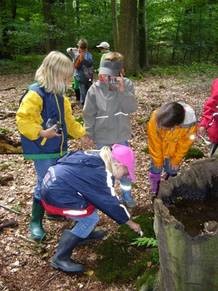
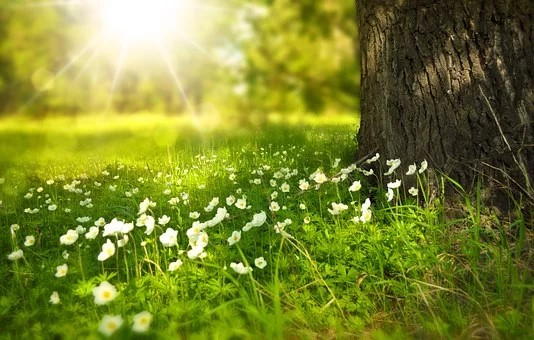
The forest in autumn
Duration: 2,5 - 3,5 hours
There is a lot to discover in autumn! The leaves of the deciduous trees shine in bright colors and gently fall to the ground. Squirrels & Co. diligently collect ripe fruits and seeds and create food supplies. The plants and animals of the forest are preparing for winter! But why aren't the leaves on the forest floor many meters high when they fall from the trees every autumn? And why don't most conifers lose their leaves? During this excursion, the students explore the differences between conifers and deciduous trees and the characteristic features of the leaves and fruits of individual tree species. You will learn about the seasonal adaptations of plants and animals and reflect on the possible effects of climate change on animal behavior. What can each individual do to help plants and animals? The pupils grasp the importance of soil organisms for the forest ecosystem and can actively search for soil animals, which they can examine with a magnifying glass and identify with the help of card files. All subject areas offer the opportunity to play nature adventure games.



Meadow
Duration: 2 - 3 hours
Colorful meadows resemble a sea of colors and scents and provide a habitat for numerous residents. On this excursion, the students explore the meadow as a habitat and understand its importance for a wide variety of animal and plant species. They describe the floors of a meadow, discover their different inhabitants and playfully learn about their special adaptations and their ecological significance for the living space. The pupils look at the structure of certain plants in the meadow, take a close look at the leaves and petals and thus get to know the different meadow plants. They try out methods of nature observation, document their observations, collect and organize materials from the meadow habitat according to certain criteria and recognize the motley diversity of their immediate natural surroundings. You will get to know different types of meadow and reflect on the influence and use of the meadow as a habitat by humans. The direct contact with nature promotes a sense of responsibility towards other living beings and a careful handling of them.
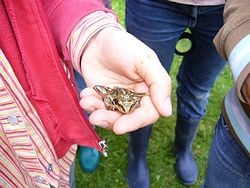
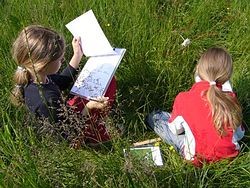
waters
Im Tiergarten Schloss Raesfeld there are many different types of water bodies. The Castle Gräfte, several ponds, streams, springs and other seasonal bodies of water offer an ideal opportunity to take a closer look at the subject of bodies of water.
Water detectives
Duration: 3 - 3,5 hours
After a brief introduction to the topic of the excursion and the knowledge gained through play that water is a vital resource for people, plants and animals, younger pupils are allowed to transform themselves into aquatic animals. In the green classroom NaturparkAt home, a frog mask will be made together, which can be worn during the following excursion. Through their own "transformation" the students can better put themselves in the position of the animals and understand their ways of life, behavior and needs. Older students make their way straight to the event location, the Wellbrockquelle. Along the way, the students learn a lot of interesting facts about the formation of different bodies of water and about their importance for people in the past and today. In addition, many animals can already be observed that stay at the water, such as ducks, rails, swans, geese and gray herons. The pupils then have the opportunity to independently explore the Bach habitat. You discover its most diverse inhabitants, examine them and recognize their special adaptations to the
Habitat. Relationships between habitats and living conditions for animals become clear.


Water quality
Duration: 2,5 - 3,5 hours
Clean and healthy water is a vital resource for people, plants and animals! But not all water is created equal. Some bodies of water appear crystal clear, while others are cloudy and muddy. The smell can also vary widely. Turbidity, color and smell provide an indication of the quality of a body of water and the nutrient content also plays a major role. Since different animal species place different demands on their habitat, the community of a water body can also provide information about its quality. The water quality is often influenced by humans, for example through the discharge of sewage, agricultural fertilization or cooling water from power plants. In this excursion, the pupils get to know the diversity of water as a habitat and, with the help of physical, chemical and biological studies, determine the water quality of a flowing water in their immediate vicinity. They describe the state of the water, determine the nutrients it contains, discover its diverse inhabitants and explore their special adaptations to their habitat. They recognize connections between habitats and living conditions for animals and the influence of humans on the habitat of water.
Topics in the annual cycle
Early bloomer
In early spring the zoo comes to life again. Wood anemones and lesser celandine form a wonderful carpet of flowers that invites you to take a closer look and examine. In addition, other early bloomers such as daisies, wood sorrel or Gundermann line the path.
With the help of identification cards, early bloomers can be viewed and identified more precisely based on their leaves and petals. The storage organs can be discussed in terms of structure and function. Simple experiments to prove strengths can also be carried out in nature. The pupils recognize the connection between light conditions on the forest floor and the development of the early bloomers.
Forest fruits
In autumn, a large number of forest fruits invite you to collect and examine them closely.
With the help of identification cards, the fruits can be assigned to the tree species.
Using very concrete examples, the distribution of fruits by the wind, water or animals can be worked out. The question is asked why the tree produces fruit in the first place.
Feed marks on spruce cones
Traces of eating on spruce cones can be discussed at any time, especially in the cold season. During this time, squirrels, mice, woodpeckers and occasionally crossbills are guests in the spruce forest, because they find a nutritious core under the scales of the spruce cones. The pupils collect cones with traces of food, look at them carefully, compare them and find out that each of these animals has developed its own technique for obtaining the nutritious seeds.
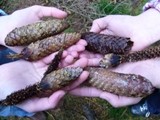
For information: The use of the Biparcours app is reserved exclusively for pupils.
BIPARCOURS code:

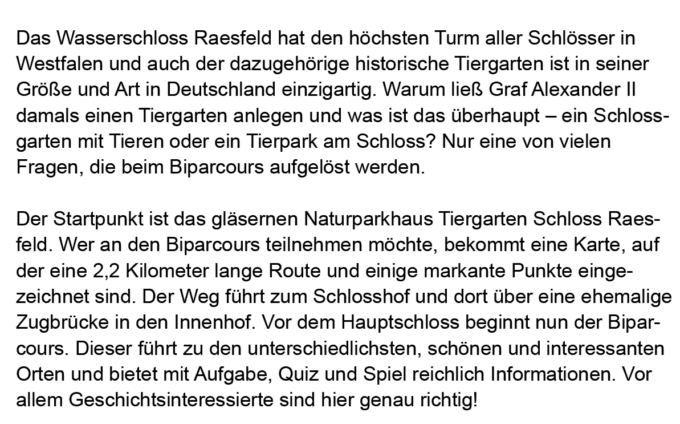
dr Stefanie Bolting
Naturparkhouse Tiergarten Schloss Raesfeld
Tiergarten 1
46348 Raesfeld
Phone: 0163 / 7335608
Phone: 02564 / 98600
E-mail: lernwerkstatt@raesfeld.de
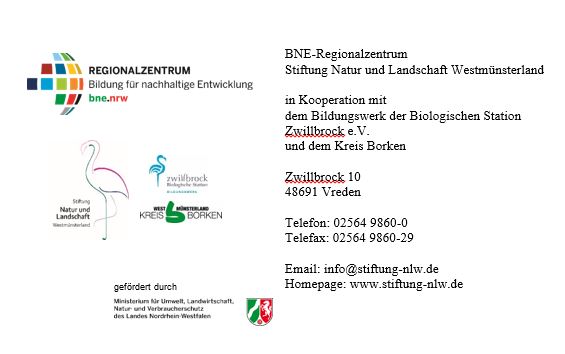
Follow us on the web.